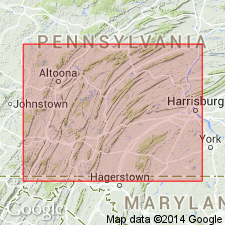
- Usage in publication:
-
- Corriganville Limestone
- Modifications:
-
- Named
- Dominant lithology:
-
- Limestone
- Chert
- AAPG geologic province:
-
- Appalachian basin
Summary:
Corriganville Limestone of Helderberg Group named for town in Allegany Co., MD. Extends from MD to VA, WV, PA, and NY, where it replaces New Scotland Limestone. Unit is a gray limestone with chert, 8 m thick at the type section. Overlies New Creek Limestone; underlies Licking Creek Limestone or Mandata Shale. Age is Early Devonian.
Source: GNU records (USGS DDS-6; Reston GNULEX).
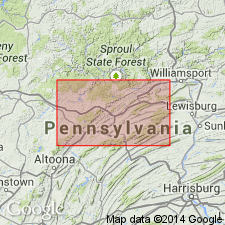
- Usage in publication:
-
- Corriganville Member*
- Modifications:
-
- Revised
- AAPG geologic province:
-
- Appalachian basin
Summary:
Lower Devonian Corriganville Limestone of Head (1972) is revised as Corriganville Member and assigned to the Old Port Formation from MD to central PA, following the usage of the Pennsylvanian Geological Survey. Underlies Shriver Member and overlies New Creek Member, both of Old Port.
Source: GNU records (USGS DDS-6; Reston GNULEX).
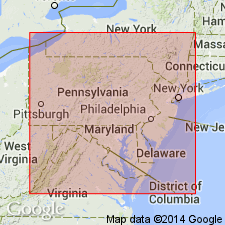
- Usage in publication:
-
- Corriganville Limestone*
- Modifications:
-
- Areal extent
- Overview
- AAPG geologic province:
-
- Appalachian basin
Summary:
Corriganville Limestone is used in this report in west-central VA, WV, and central PA [and MD by implication]. It overlies the New Creek Limestone; is equivalent to the New Scotland Formation.
Source: GNU records (USGS DDS-6; Reston GNULEX).
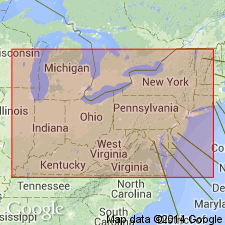
- Usage in publication:
-
- Corriganville Limestone
- Modifications:
-
- Revised
- AAPG geologic province:
-
- Appalachian basin
Summary:
Newly named Bald Hill Bentonite Beds A and B occur within the New Scotland Formation in PA and WV and within the correlative Corriganville Limestone in MD. Bed C is found near the base of the overlying Mandata in all three states. In NY, Beds A, B, and C occur within the middle member of Kalkberg Limestone. Bald Hill Bentonite Bed A is presumably equivalent to Rickard's (1962) Kalkberg bentonite.
Source: GNU records (USGS DDS-6; Reston GNULEX).

- Usage in publication:
-
- Corriganville Limestone
- Modifications:
-
- Overview
- AAPG geologic province:
-
- Appalachian basin
Summary:
At the type locality of the Lower Devonian Bald Hill Bentonites in Blair Co., south-central PA, bentonites A and B both occur within the Corriganville Limestone. Bentonite C is in the overlying Mandata Shale. Smith and Berkheiser (1992: GSA Abs, NE section) also identified the three bentonites at Black Oak Ridge, Bedford Co., PA, approximately 40 km south-southwest of Bald Hill. Here Bald Hill Bentonite A is a 2.5-cm-thick grayish yellow waxy claystone in the Corriganville Limestone and is 58 cm below bentonite B, a 1-cm-thick olive-gray waxy mudstone. Bentonite B is located at the Corriganville Limestone-Mandata Shale boundary at Black Oak Ridge, while at the type section, B occurs 42 cm below the boundary. The top of the Corriganville is therefore not isochronous, as suggested by Goodwin and Anderson (1985: Journal of Geology, v. 93, p. 515-533). Bentonite C occurs only 18 cm above the boundary and consists of less than 1 cm of olive-black biotitic mudstone.
Source: GNU records (USGS DDS-6; Reston GNULEX).
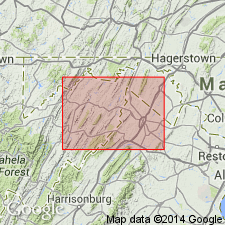
- Usage in publication:
-
- Corriganville Limestone*
- Modifications:
-
- Biostratigraphic dating
- AAPG geologic province:
-
- Appalachian basin
Summary:
Conodont biostratigraphy indicates that the Corriganville Limestone in the Winchester 30 X 60 minute quadrangle is of earliest Devonian (early Lochkovian) age. Conodonts as old as the I. WOSCHMIDTI Zone and as young as the O. DELTA Zone were recovered from this unit.
Source: GNU records (USGS DDS-6; Reston GNULEX).
For more information, please contact Nancy Stamm, Geologic Names Committee Secretary.
Asterisk (*) indicates published by U.S. Geological Survey authors.
"No current usage" (†) implies that a name has been abandoned or has fallen into disuse. Former usage and, if known, replacement name given in parentheses ( ).
Slash (/) indicates name conflicts with nomenclatural guidelines (CSN, 1933; ACSN, 1961, 1970; NACSN, 1983, 2005, 2021). May be explained within brackets ([ ]).

